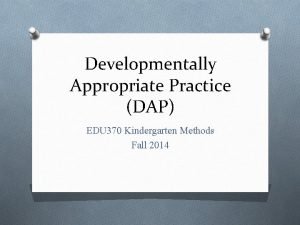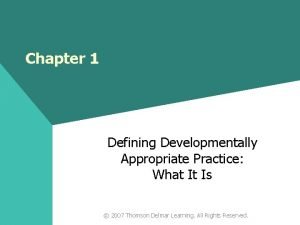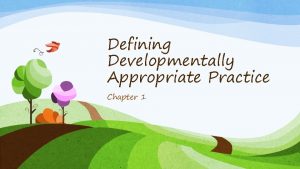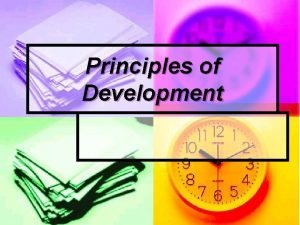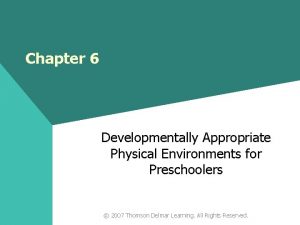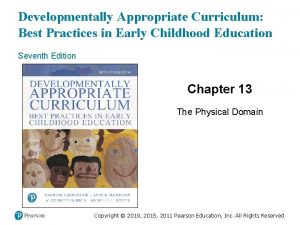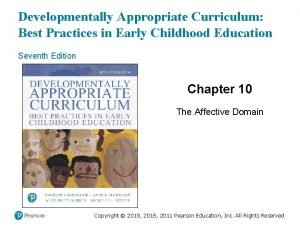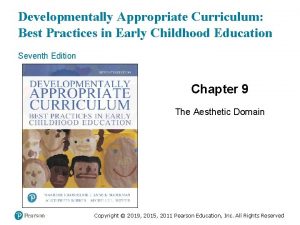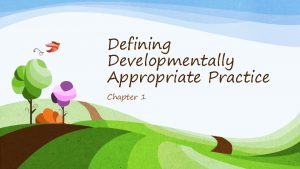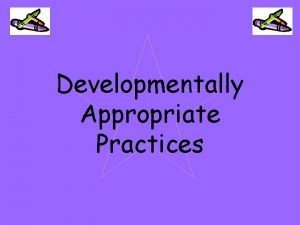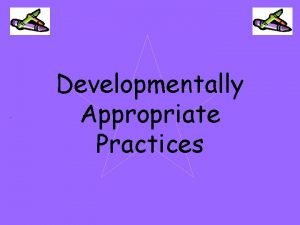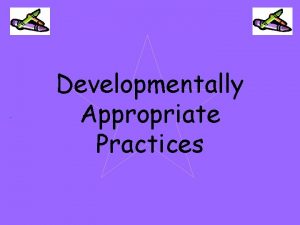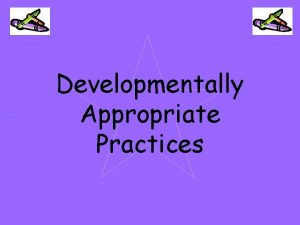Chapter 1 Defining Developmentally Appropriate Practice What It








- Slides: 8

Chapter 1 Defining Developmentally Appropriate Practice: What It Is © 2007 Thomson Delmar Learning. All Rights Reserved.

Developmentally Appropriate Practice—What Is It? a. Programs are based on the accumulation of data and facts about what children are like b. Programs designed for young children must be based on what is known about young children c. Early childhood educators must be steeped in child development knowledge d. Children must be considered in the context of their family, culture, community, past history, and present circumstances © 2007 Thomson Delmar Learning. All Rights Reserved.

Basic Principles of Development • Domains of children’s develop-ment • Early experiences have both cumulative and delayed effects —physical, social, emotional, and on individual children’s cognitive—are closely related. development; Optimal periods Development in one domain exist for certain types of influences and is influenced by development and learning development in other domains • Development proceeds in • Development occurs in a relatively predictable directions toward orderly sequence, with later abilities, greater complexity, skills, and knowledge building on organization, and internalization those already acquired • Development and learning • Development proceeds at varying occur in and are influenced by rates from child to child as well as multiple social and cultural unevenly within different areas of a contexts child’s functioning © 2007 Thomson Delmar Learning. All Rights Reserved.

Basic Principles of Development • Children are active learners, drawing on direct physical and social experience as well as culturally transmitted knowledge to construct their own understanding of the world around them • Development and learning result from interaction of biological maturation and the environment, which includes both the physical and social worlds that children live in • Play is an important vehicle for children’s social, emotional, and cognitive development, as well as a reflection of their development • Development advances when children have opportunities to practice newly acquired skills as well as when they experience a challenge just beyond the level of their present mastery • Children demonstrate different modes of knowing and learning and different ways of representing what they know • Children develop and learn best in the context of a community where they are safe and valued, their physical needs are met, and they feel psychologically secure © 2007 Thomson Delmar Learning. All Rights Reserved.

Common Misunderstandings about Developmentally Appropriate Practice • There is only one right way to carry out developmentally appropriate practice • Developmentally appropriate classrooms are unstructured • Teachers teach minimally or not at all in developmentally appropriate classrooms © 2007 Thomson Delmar Learning. All Rights Reserved.

Common Misunderstandings about Developmentally Appropriate Practice • Developmentally appropriate programs do not include academics, generally interpreted to be the formal skills of learning reading, writing, and arithmetic • Developmentally appropriate programs are only effective for particular populations, “usually assumed to be typically developing, white, middle-class children” • In developmentally appropriate classrooms, there is no way to tell whether children are learning © 2007 Thomson Delmar Learning. All Rights Reserved.

Common Misunderstandings about Developmentally Appropriate Practice • Developmentally appropriate practice can be achieved simply by acquiring certain kinds of toys and materials • Developmentally appropriate practice uses no goals or objectives • In developmentally appropriate practice, the curriculum is child development • Developmental appropriateness is just one in a sequence of changing trends in education © 2007 Thomson Delmar Learning. All Rights Reserved.

Results of Appropriate versus Inappropriate Practices • Self-esteem – mastering – meaningful • Self-control • Stress • Later academic patterns © 2007 Thomson Delmar Learning. All Rights Reserved.
 10 effective dap teaching strategies
10 effective dap teaching strategies Define developmentally appropriate practice
Define developmentally appropriate practice Define developmentally appropriate practice
Define developmentally appropriate practice Development occurs in a relatively orderly sequence
Development occurs in a relatively orderly sequence Developmentally appropriate environment
Developmentally appropriate environment Developmentally appropriate curriculum 7th edition
Developmentally appropriate curriculum 7th edition Developmentally appropriate curriculum 7th edition
Developmentally appropriate curriculum 7th edition Developmentally appropriate curriculum 7th edition
Developmentally appropriate curriculum 7th edition Examples of non defining relative clause
Examples of non defining relative clause
